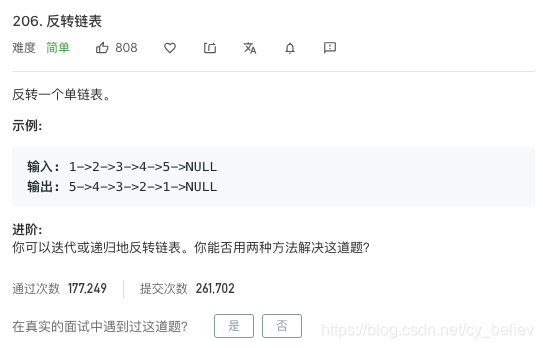
题解:
本题有两种实现方法,分别是迭代法和递归法;
方法一:迭代法:
利用双指针进行实现
两个指针分别是pre, curr;
再加一个临时变量temp;
- pre初始化为None;curr初始化为head;
- 然后令temp=curr.next(保存下一个结点,以便后面使用);
- curr.next = pre(建立当前结点和它前面结点之间的连接关系);
- pre = curr(往前移动pre);
- curr = temp(往前移动curr);
- 最后curr为None,返回pre即为最后一个结点。
图解如下所示:
第一次迭代:

第二次迭代:

代码如下:
# Definition for singly-linked list.
# class ListNode:
# def __init__(self, x):
# self.val = x
# self.next = None
class Solution:
def reverseList(self, head):
pre = ListNode(None)
curr = head
tmp = ListNode(None)
while curr:
tmp = curr.next
curr.next = pre
pre = curr
curr = tmp
return pre
方法二:递归法
(结合代码来看更容易理解)
对于一个给定的链表,我们首先需要遍历到链表的尾端,例如对于[1,2,3,4,5],递归遍历到最后返回5;
即当前的head值为5,head.next 为None,head.next.next为None所指向的结点, head.next.next赋值为结点5(head.next.next = head),实现了链表方向的反向连接,然后进行递归返回; 返回后cur为5,head就变为了4,此时head.next = 5, head.next.next就是结点5的指针指向的结点;因此我们把head.next.next 赋值为head,就实现了结点5到结点4的反向连接。
递归过程如下所示:
1–>2–>3–>4–>5–>None
- 先遍历到链表的末尾,
head = 1 … head.next=2
head = 2 … head.next=3
head = 3 … head.next=4
head = 4 … head.next=5
head = 5 … head.next= None - 递归返回一
此时遇到递归终止条件,进行返回,返回当前的head 为5,即cur=5;此时head.next.next为Null指向的结点我们赋值为head,首先了null指向head结点(5)的效果。
如下图所示:

- 递归返回二
cur值为5,head此时为4,head.next为结点5, 因此head.next.next = head就实现了下述效果

为了防止出现环路,我们需要设置head.next = None。
后面的递归返回如上述一次进行,最后head为1。
代码如下:
class Solution:
def reverseList(self, head):
if head == None or head.next == None:
return head
cur = reverseList(head.next)
head.next.next = head
head.next = None
return cur
